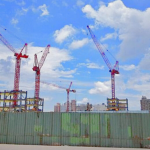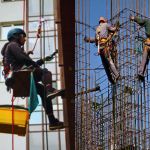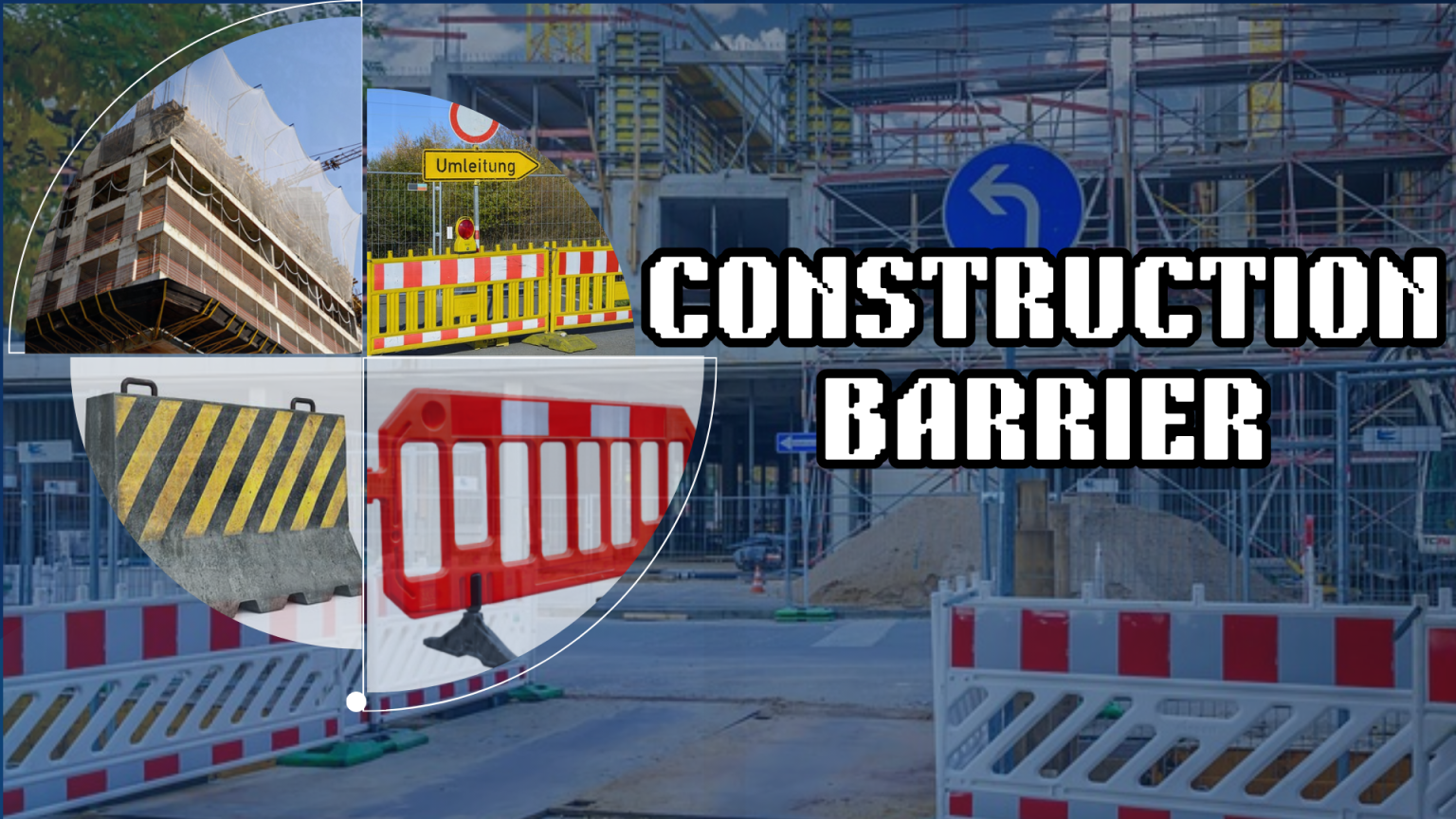
CONSTRUCTION BARRIER
A construction barrier, also known as a construction barricade, is a physical barrier or structure erected at a construction site to control access, enhance safety, and protect workers and the public. Construction barriers serve various functions and can be made from different materials.
Here are some key aspects of construction barriers:
- Boundaries
- Access Control
- Safety Measures
- Traffic Management
- Falling Object Protection
- Visual Warning
- Noise and Dust Control
- Site Organization
Types of Construction Barrier
There are various types of construction barriers used depending on the specific requirements of the construction site.
Concrete Construction Barrier
Concrete construction barriers are widely used in construction projects and road works to provide physical protection and control traffic. They are made of reinforced concrete and are designed to be durable and resistant to impact.

Concrete construction barriers provide a strong physical barrier, improve safety on construction sites, and help control traffic flow. Reflective markings are applied on these to improve visibility. They can withstand harsh weather conditions and offer protection against vehicle collisions and unauthorized access.
Plastic Construction Barrier
Plastic construction barriers, also known as plastic barricades or plastic barriers, are lightweight and versatile barriers commonly used in construction, roadwork, and crowd control situations.
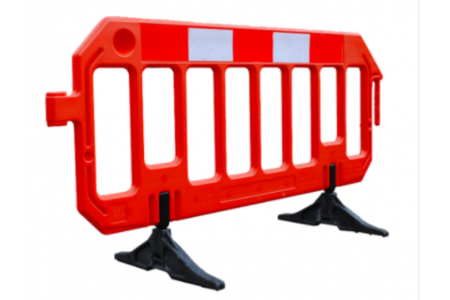
Plastic construction barriers are popular due to their lightweight nature, ease of handling, and portability. They can be easily transported, set up, and rearranged as needed, making them convenient for temporary applications. However, it’s important to note that plastic barriers may not offer the same level of strength and durability as concrete barriers, and their effectiveness may vary depending on the specific use case.
Guardrail
A guardrail is a type of construction barrier designed to provide protection and prevent accidents in various settings, including highways, roads, bridges, and construction sites.
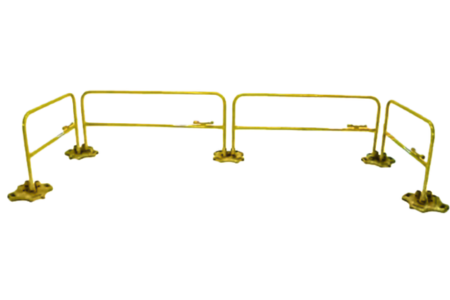
Guard rails undergo rigorous testing and adhere to specific standards and regulations to ensure their effectiveness in providing safety and preventing accidents. They are typically installed at appropriate distances along roadways and at critical locations where the risk of vehicles leaving the road is high.
Fencing
A fencing construction barrier is a type of barrier made of fencing materials that is commonly used in construction sites, events, or other areas where controlled access or security is required. Fencing barriers help establish boundaries, restrict entry, enhance safety, and provide a visible barrier.
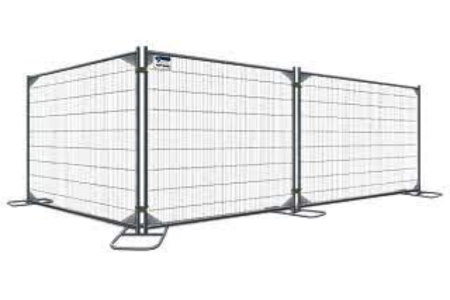
Fencing construction barriers can be customized to fit specific site requirements and are often supplemented with gates, locks, warning signs, or additional security measures as needed. They help maintain site safety, prevent unauthorized entry, and protect both workers and the public during construction activities.
Safety Nets
Safety nets are an essential construction barrier used to protect workers and prevent falling objects or individuals from heights. They are designed to catch and absorb the energy of a fall, reducing the risk of injuries and fatalities. Safety nets are typically used in construction sites, bridge construction, roofing work, and other elevated work areas.
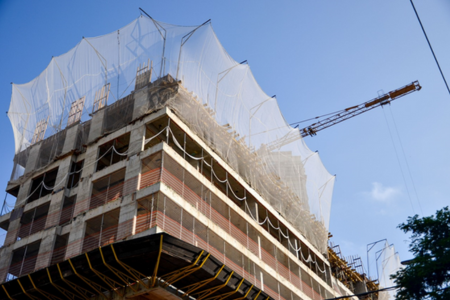
Safety nets as construction barriers provide an additional layer of protection for workers and the public in construction areas where falls or falling objects are potential hazards. They play a crucial role in maintaining a safe working environment and preventing accidents during construction activities at heights.
Advantages of Construction Barriers in Construction Site
Construction barriers offer several advantages in construction sites, contributing to improved safety, efficiency, and organization.
Safety
Construction barriers enhance safety by creating a physical separation between construction activities and the surrounding area. They help prevent unauthorized access, reduce the risk of accidents, and protect workers and the public from potential hazards.
Hazard Mitigation
Barriers are effective in mitigating potential hazards in construction sites. They can prevent falls from elevated surfaces, redirect vehicular or pedestrian traffic away from work zones, and contain debris or falling objects, reducing the likelihood of injuries or property damage.
Enhanced Security
Construction barriers provide a level of security by restricting access to construction areas. They help deter theft, vandalism, or unauthorized entry, safeguarding valuable equipment, materials, and infrastructure.
Traffic Control
Barriers such as traffic cones, barricades, or signage assist in controlling vehicular and pedestrian traffic around construction zones. They help direct traffic flow, provide visual cues, and communicate temporary changes or detours, ensuring smooth and organized movement.
Regulatory Compliance
Construction barriers help fulfill regulatory requirements and industry standards for construction site safety. Using appropriate barriers demonstrates compliance with safety regulations, protecting the interests of construction companies and ensuring legal adherence.
Property Protection
Barriers can also protect adjacent properties and infrastructure from damage caused by construction activities. They prevent accidental encroachment, vehicle collisions, or debris from spreading beyond the construction area.
Organization and Efficiency
By clearly marking boundaries and establishing designated work areas, construction barriers contribute to better organization and efficiency. They help prevent interference with ongoing construction work, maintain the flow of operations, and improve overall productivity.
Compliance with Regulations
Construction barriers play a crucial role in meeting regulatory requirements. They ensure that construction sites adhere to safety standards, local building codes, and zoning regulations, avoiding potential legal issues or penalties.
Communication and Awareness
Construction barriers often include warning signs, caution tapes, or reflective elements to increase visibility and communicate important safety information. They help raise awareness among workers, visitors, and the public about potential hazards and safety precautions.
Construction barriers provide a range of benefits, including increased safety, hazard mitigation, crowd control, security, property protection, improved organization, regulatory compliance, and effective communication in construction sites.
Also Read: Reinforcement Splicing | Different Types of Fences | Fiber Reinforced Concrete | Foam Concrete
Location of Construction Barriers on the Construction Site
Construction barriers are strategically placed at various locations within a construction site to fulfill their intended purposes. The specific locations of construction barriers may vary depending on the nature of the project, site layout, and safety requirements. Here are some common locations where construction barriers are typically installed:
Hazardous Areas
Barriers are used to mark and restrict access to hazardous areas within the construction site, such as excavations, trenches, open pits, or areas with potential falling objects. They help prevent accidental falls, collisions, or incidents.
Work Zones
Construction barriers are placed around specific work zones or active construction areas to separate them from other parts of the site. This helps protect workers and keeps unauthorized personnel away from ongoing construction activities.
Temporary Traffic Control
In construction projects that affect vehicular or pedestrian traffic, barriers are used to guide and control the flow of vehicles and pedestrians. They can include temporary traffic cones, barricades, or delineators to redirect traffic and ensure safety.
Equipment Storage Areas
Barriers may be used to designate specific areas for equipment storage or material stockpiles within the construction site. This helps organize the site and prevents interference with ongoing construction work.
Public Spaces
If the construction site is adjacent to public spaces or sidewalks, barriers are often placed to protect the public and maintain clear pathways for pedestrians. This prevents accidental entry into the construction zone and ensures public safety.
Equipment Storage Areas
Barriers may be used to designate specific areas for equipment storage or material stockpiles within the construction site. This helps organize the site and prevents interference with ongoing construction work.
Pedestrian Walkways
Construction barriers are installed to create designated pedestrian walkways or paths, especially in areas where foot traffic needs to be separated from vehicular traffic or construction activities. This helps ensure the safety of pedestrians navigating through the site.
Equipment Storage Areas
Barriers may be used to designate specific areas for equipment storage or material stockpiles within the construction site. This helps organize the site and prevents interference with ongoing construction work.
Perimeter
Construction barriers are often placed along the perimeter of the construction site to establish a clear boundary and prevent unauthorized access. This includes fencing or barricades around the entire site, ensuring that only authorized personnel can enter.
Entrances and Exits
Construction barriers are positioned at designated entrances and exits to control access and monitor the movement of personnel, vehicles, and equipment. Gates, turnstiles, or checkpoints may be incorporated into the barriers for efficient access management.
The placement of construction barriers should be based on safety regulations, site-specific requirements, and risk assessments conducted by the construction management team. It is crucial to regularly assess and adjust the barrier placement as the project progresses and site conditions change.



